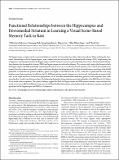Functional Relationships between the Hippocampus and Dorsomedial Striatum in Learning a Visual Scene-Based Memory Task in Rats
Author(s)
Delcasso, Sebastien; Huh, Namjung; Byeon, Jung Seop; Lee, Jihyun; Jung, Min Whan; Lee, Inah; ... Show more Show less
DownloadDelcasso-2014-Functional relations.pdf (1.504Mb)
PUBLISHER_POLICY
Publisher Policy
Article is made available in accordance with the publisher's policy and may be subject to US copyright law. Please refer to the publisher's site for terms of use.
Terms of use
Metadata
Show full item recordAbstract
The hippocampus is important for contextual behavior, and the striatum plays key roles in decision making. When studying the functional relationships with the hippocampus, prior studies have focused mostly on the dorsolateral striatum (DLS), emphasizing the antagonistic relationships between the hippocampus and DLS in spatial versus response learning. By contrast, the functional relationships between the dorsomedial striatum (DMS) and hippocampus are relatively unknown. The current study reports that lesions to both the hippocampus and DMS profoundly impaired performance of rats in a visual scene-based memory task in which the animals were required to make a choice response by using visual scenes displayed in the background. Analysis of simultaneous recordings of local field potentials revealed that the gamma oscillatory power was higher in the DMS, but not in CA1, when the rat performed the task using familiar scenes than novel ones. In addition, the CA1-DMS networks increased coherence at γ, but not at θ, rhythm as the rat mastered the task. At the single-unit level, the neuronal populations in CA1 and DMS showed differential firing patterns when responses were made using familiar visual scenes than novel ones. Such learning-dependent firing patterns were observed earlier in the DMS than in CA1 before the rat made choice responses. The present findings suggest that both the hippocampus and DMS process memory representations for visual scenes in parallel with different time courses and that flexible choice action using background visual scenes requires coordinated operations of the hippocampus and DMS at γ frequencies.
Date issued
2014-11Department
McGovern Institute for Brain Research at MITJournal
Journal of Neuroscience
Publisher
Society for Neuroscience
Citation
Delcasso, S., N. Huh, J. S. Byeon, J. Lee, M. W. Jung, and I. Lee. “Functional Relationships Between the Hippocampus and Dorsomedial Striatum in Learning a Visual Scene-Based Memory Task in Rats.” Journal of Neuroscience 34, no. 47 (November 19, 2014): 15534–15547.
Version: Final published version
ISSN
0270-6474
1529-2401